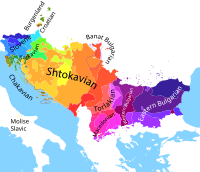Eastern Romance influence on Slavic languages
Although the direction of language contact between Romanian and Slavic languages is overwhelmingly towards Romanian and its South Danubian varieties (Aromanian, Megleno-Romanian, and Istro-Romanian) there is evidence of lesser influence in the opposite direction as well. Romanian influence on Slavic Languages is generally limited to neighbouring languages, and of those to the South Slavic languages more than the northern counterparts.
Romanian influence on South Slavic languages

Romanian influence is most visible on South Slavic languages, in particular Bulgarian and Macedonian which goes back to the earliest centuries after the invasion of Slavic tribes in the south-Danubian territory. The lexical borrowings dominate in its shepherd and dairy-farming terminology, for example: fičor ‘young shepherd’ ← ficior, zira ‘whey’ ← zer.[1] Linguist Maria Osman-Zavera discusses more than 200 lexical units of Romanian provenience in Bulgarian dialects.[2] The discourse marker май in Bulgarian is unanimously accepted as a Romanian loan.[3]
Aromanian seemed to have been the calque-source for the possessive perfect in Macedonian [4]
Examples of words that entered Serbo-Croatian:[5]
brnduša < brândușă (crocus), burdelji < bordei (hut, cottage), kaš < caș (a type of cheese), čutura < ciutură (wooden vessel for wine or brandy), kustura < custură (a rocky promontory), mamaliga < mămăligă (polenta), pujka < puică (young little hen).
Romanian influence on East and West Slavic languages
Czech, Polish, and Slovak languages have a few words from Romanian related to shepherd and farming terminology such as Slovak/Polish bryndza / Czech/Ukrainian brynza ‘sheep cheese’ ← Rom. brânză or Czech/Polish/Slovak koliba / Ukrainian (dial.) kolyba ‘hut, shelter’ ← Rom. colibă, although it is not clear if they are direct borrowings in each of these languages or internally Slavic mediation of borrowings.[6]
Of the West and East Slavic languages more words seem to have entered Ukrainian, mostly at a dialectal level, and perhaps trough mediation of the Moldovan subdialect: fryka ‘fear’ ← frică, pizma ‘envy’ ← pizmă, korkobec’ ‘pumpkin’ ← curcubetă, part’ ‘part’ ← parte, harmasar ‘stallion’ ← armăsar, plačynda ‘pancake’ ← plăcintă, and tajstra ‘shoulder bag’ ← traistă.[7]
Some Romanian linguists maintain that the word "ciumă" ‘plague’ that has a wider distribution than just in the neighbouring Slavic languages is inherited in Romanian from Latin.[8]
References
- ^ Breu, Walter (23 March 2022). "Romance in Contact with Slavic in Southern and South-Eastern Europe".
- ^ Breu, Walter (23 March 2022). "Romance in Contact with Slavic in Southern and South-Eastern Europe".
- ^ Mladenova, Olga M - Bulgarian maj: From Approximation to Modality?
- ^ Anastasia Makarova - On the Macedonian Perfect(s) in the Balkan Context
- ^ Rosetti, Alexandru (1986). Istoria limbii române, vol I [History of Romanian Language, volume 1] (in Romanian). Editura Științifică și Enciclopedică. p. 305.
- ^ Breu, Walter (24 February 2022). "Romance in Contact With Slavic in Central and Eastern Europe". Oxford Research Encyclopedias.
- ^ Breu, Walter (24 February 2022). "Romance in Contact With Slavic in Central and Eastern Europe". Oxford Research Encyclopedias.
- ^ Sala, Marius (2012). De la Latină la Română] [From Latin to Romanian]. Editura Pro Universitaria. p. 88. ISBN 978-606-647-435-1.
